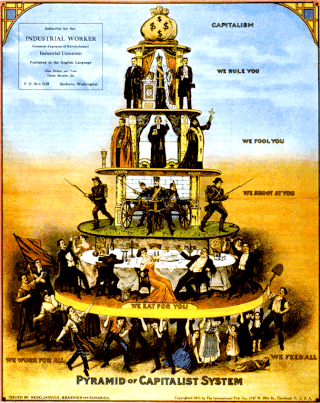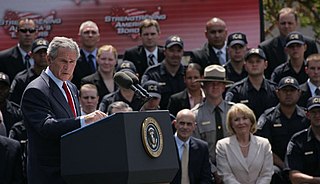Propaganda is communication that is primarily used to influence or persuade an audience to further an agenda, which may not be objective and may be selectively presenting facts to encourage a particular synthesis or perception, or using loaded language to produce an emotional rather than a rational response to the information that is being presented. Propaganda can be found in a wide variety of different contexts.

Persuasion or persuasion arts is an umbrella term for influence. Persuasion can influence a person's beliefs, attitudes, intentions, motivations, or behaviours.

A hoax is a widely publicized falsehood so fashioned as to invite reflexive, unthinking acceptance by the greatest number of people of the most varied social identities and of the highest possible social pretensions to gull its victims into putting up the highest possible social currency in support of the hoax.
Disinformation is false information deliberately spread to deceive people. Disinformation is an orchestrated adversarial activity in which actors insert strategic deceptions and media manipulation tactics to advance political, military, or commercial goals. Disinformation is implemented through attacks that weaponize multiple rhetorical strategies and forms of knowing—including not only falsehoods but also truths, half-truths, and value judgements—to exploit and amplify culture wars and other identity-driven controversies."
Deception is an act or statement that misleads, hides the truth, or promotes a belief, concept, or idea that is not true. This occurs when a deceiver uses information against a person to make them believe an idea is true. Deception can be used with both verbal and nonverbal messages. The person creating the deception knows it to be false while the receiver of the message has a tendency to believe it. It is often done for personal gain or advantage. Deception can involve dissimulation, propaganda and sleight of hand as well as distraction, camouflage or concealment. There is also self-deception, as in bad faith. It can also be called, with varying subjective implications, beguilement, deceit, bluff, mystification, ruse, or subterfuge.

Media manipulation is a series of related techniques in which partisans create an image or argument that favors their particular interests. Such tactics may include the use of logical fallacies, manipulation, outright deception (disinformation), rhetorical and propaganda techniques, and often involve the suppression of information or points of view by crowding them out, by inducing other people or groups of people to stop listening to certain arguments, or by simply diverting attention elsewhere. In Propaganda: The Formation of Men's Attitudes, Jacques Ellul writes that public opinion can only express itself through channels which are provided by the mass media of communication – without which there could be no propaganda. It is used within public relations, propaganda, marketing, etc. While the objective for each context is quite different, the broad techniques are often similar.
Appeal to emotion or argumentum ad passiones is an informal fallacy characterized by the manipulation of the recipient's emotions in order to win an argument, especially in the absence of factual evidence. This kind of appeal to emotion is irrelevant to or distracting from the facts of the argument and encompasses several logical fallacies, including appeal to consequences, appeal to fear, appeal to flattery, appeal to pity, appeal to ridicule, appeal to spite, and wishful thinking.

Conversation is interactive communication between two or more people. The development of conversational skills and etiquette is an important part of socialization. The development of conversational skills in a new language is a frequent focus of language teaching and learning. Conversation analysis is a branch of sociology which studies the structure and organization of human interaction, with a more specific focus on conversational interaction.
Word of mouth, also called viva voce, is the passing of information from person to person using oral communication, which could be as simple as telling someone the time of day. Storytelling is a common form of word-of-mouth communication where one person tells others a story about a real event or something made up. Oral tradition is cultural material and traditions transmitted by word of mouth through successive generations. Storytelling and oral tradition are forms of word of mouth that play important roles in folklore and mythology. Another example of oral communication is oral history—the recording, preservation and interpretation of historical information, based on the personal experiences and opinions of the speaker. Oral history preservation is the field that deals with the care and upkeep of oral history materials collected by word of mouth, whatever format they may be in.

In social psychology, pluralistic ignorance is a phenomenon in which people mistakenly believe that others predominantly hold an opinion different from their own. In this phenomenon, most people in a group may go along with a view they do not hold because they think, incorrectly, that most other people in the group hold it. Pluralistic ignorance encompasses situations in which a minority position on a given topic is wrongly perceived to be the majority position, or the majority position is wrongly perceived to be a minority position.

Gordon Willard Allport was an American psychologist. Allport was one of the first psychologists to focus on the study of the personality, and is often referred to as one of the founding figures of personality psychology. He contributed to the formation of values scales and rejected both a psychoanalytic approach to personality, which he thought often was too deeply interpretive, and a behavioral approach, which he thought did not provide deep enough interpretations from their data. Instead of these popular approaches, he developed an eclectic theory based on traits. He emphasized the uniqueness of each individual, and the importance of the present context, as opposed to history, for understanding the personality.
Misinformation is incorrect or misleading information. It differs from disinformation, which is deliberately deceptive and propagated information. Early definitions of misinformation focused on statements that were patently false, incorrect, or not factual. Therefore, a narrow definition of misinformation refers to the information's quality, whether inaccurate, incomplete, or false. However, recent studies define misinformation per deception rather than informational accuracy because misinformation can include falsehoods, selective truths, and half-truths.
Floyd Henry Allport was an American psychologist who is often considered "the father of experimental social psychology", having played a key role in the creation of social psychology as a legitimate field of behavioral science. His book Social Psychology (1924) impacted all future writings in the field. He was particularly interested in public opinion, attitudes, morale, rumors, and behavior. He focused on exploration of these topics through laboratory experimentation and survey research.

Propaganda techniques are methods used in propaganda to convince an audience to believe what the propagandist wants them to believe. Many propaganda techniques are based on socio-psychological research. Many of these same techniques can be classified as logical fallacies or abusive power and control tactics.

Political communication is a subfield of communication and political science that is concerned with how information spreads and influences politics, policy makers, the news media, and citizens. Since the advent of the World Wide Web, the amount of data to analyze has exploded and researchers are shifting to computational methods to study the dynamics of political communication. In recent years, machine learning, natural language processing, and network analysis have become key tools in the subfield. It deals with the production, dissemination, procession and effects of information, both through mass media and interpersonally, within a political context. This includes the study of the media, the analysis of speeches by politicians, those that are trying to influence the political process, and the formal and informal conversations among members of the public, among other aspects. The media acts as a bridge between government and public. Political communication can be defined as the connection concerning politics and citizens and the interaction modes that connect these groups to each other. Whether the relationship is formed by the modes of persuasion, Pathos, Ethos or Logos.
Daniel Leonard Bernardi is a professor of Cinema at San Francisco State University, founder and President of El Dorado Films and Commander in the United States Navy Reserve. Bernardi earned a Bachelor of Arts in Radio-TV (1984) and a Masters of Arts in Media Arts (1988) from the University of Arizona. He went on to earn a PhD in Film and Television Studies from UCLA (1994) and he completed a University of California postdoctoral research fellowship in 1997.
Crowd manipulation is the intentional or unwitting use of techniques based on the principles of crowd psychology to engage, control, or influence the desires of a crowd in order to direct its behavior toward a specific action. This practice is common to religion, politics and business and can facilitate the approval or disapproval or indifference to a person, policy, or product. The ethicality of crowd manipulation is commonly questioned.
Counterpropaganda is a form of communication consisting of methods taken and messages relayed to oppose propaganda which seeks to influence action or perspectives among a targeted audience. It is closely connected to propaganda as the two often employ the same methods to broadcast messages to a targeted audience. Counterpropaganda differs from propaganda as it is defensive and responsive to identified propaganda. Additionally, counterpropaganda consists of several elements that further distinguish it from propaganda and ensure its effectiveness in opposing propaganda messages.
Post-truth politics, post-factual politics or post-reality politics, is a political culture in which facts are considered irrelevant. It suggests that the distinction between truth and falsity—as well as honesty and lying—have become a focal concern of public life, and are viewed by popular commentators and academic researchers alike as having a determinate role in how politics operates at particular points in history. It is regarded as especially being influenced by the arrival of new communication and media technologies. Popularized as a term in news media and a dictionary definition, post-truth has developed from a short-hand label for the abundance and influence of misleading or false political claims into a concept empirically studied and theorized by academic research. Oxford Dictionaries declared that its international word of the year in 2016 was "post-truth", citing a 20-fold increase in usage compared to 2015, and noted that it was commonly associated with the noun "post-truth politics".
Political bias is a bias or perceived bias involving the slanting or altering of information to make a political position or political candidate seem more attractive. With a distinct association with media bias, it commonly refers to how a reporter, news organisation, or TV show covers a political candidate or a policy issue.








